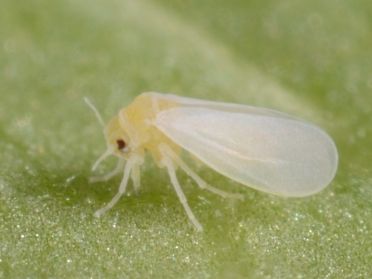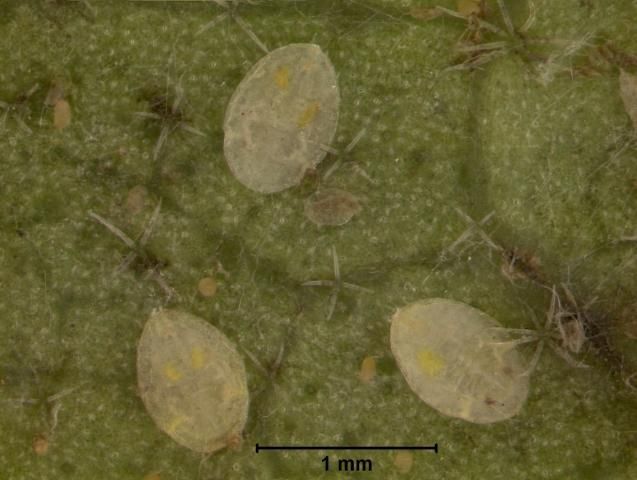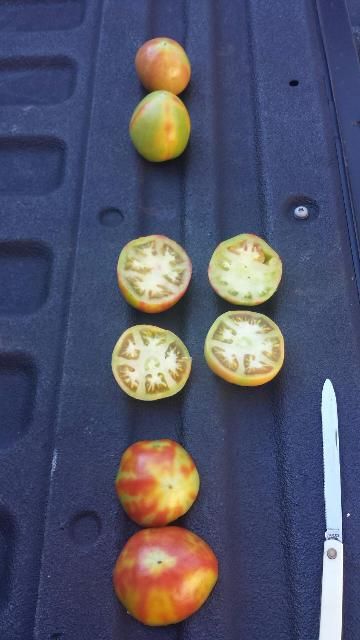A Threshold for Timing Applications of Insecticides to Manage the Silverleaf Whitefly and Irregular Ripening on Tomato
The silverleaf whitefly, Bemisia tabaci biotype B (Gennadius), has been the major pest of tomatoes in South Florida since 1988 (Schuster et al. 1989) (Figure 1). The insect causes losses indirectly through the transmission of Tomato yellow leaf curl virus in Florida (Simone et al. 1990, Polston et al. 1999). Feeding, primarily by nymphs, has been associated with an irregular ripening (IRR) disorder of fruit (Schuster et al. 1990, Schuster 2002) (Figure 2). The disorder is caused by systemically induced factors translocated through the phloem from sites of nymphal feeding to the developing fruit (Schuster et al., 1995). IRR is characterized externally by inhibited or incomplete ripening of longitudinal sections of fruit and internally by an increase in the amount of white tissue (Figure 3). No foliar symptoms are apparent.

Credit: Lyle Buss

Credit: Lyle Buss

Credit: Gary Vallad
Management of the whitefly and associated diseases and disorders includes the rigid adherence to cultural practices supplemented with insecticidal applications (Schuster et al. 1993). The systemic nicotinoid insecticide IRAC mode of action—MoA-group 4A) imidacloprid (Admire Pro, Bayer CropScience, and many generic formulations) is typically applied to seedlings 7–10 days prior to transplanting. Tomato seedlings are usually treated again at transplanting with a soil application of imidacloprid or one of two other neonicotinoid insecticides, thiamethoxam (Platinum, Syngenta Crop Protection, Inc.) or dinotefuran (Venom, Valent Agricultural Products) [PAS1]. Tomato seedlings may also be treated in the planthouse and at transplanting with flupyradifurone (Sivanto, Bayer Crop Science), a butenolide insecticide (MoA 4D) that has the same mode of action as the neonicotinoids. The diamide insecticide cyazypyr (Verimark, DuPont Crop Protection) can be used at planting but may not be applied to transplant trays more than 72 hours prior to transplanting. The diamide insecticides (MoA 28) have a mode of action that is distinct from the neonicotinoid insecticides.
Insecticides of different chemical classes are applied as needed as the effects of the transplant treatment diminish, usually after about 3 weeks. Two insect growth regulators (IGRs), buprofezin (Courier SC, Nichino America, Inc., MoA 16) and pyriproxyfen (Knack, Valent Agricultural Products, MoA 7c) are routinely used prevent the development of nymphal whiteflies on Florida tomatoes. Neither IGR kills adults; however, both sterilize eggs of treated adults, although the effect is much greater for pyriproxyfen. Buprofezin prevents successful molting at all nymphal stages while pyriproxyfen only prevents adult emergence following the last nymphal stage. Buprofezin and pyriproxifen each represent a distinct mode of action. Spirotetramat (Movento) and spiromesifen (Oberon 2SC, both Bayer Crop Science) are lipid biosynthesis inhibitors (MoA 23) that kill whitefly nymphs and reduce the fertility of whitefly females. Exirel, the foliar formulation of cyazypyr (DuPont Crop Protection) also has efficacy against whitefly nymphs.
Research was undertaken to identify the nymphal density at which buprofezin and pyriproxifen should be applied to avoid IRR. Five experiments were conducted during the spring and fall of 1997 and 1998 and the spring of 1999 at the Gulf Coast Research & Education Center, Bradenton, FL. In each experiment, three row plots were established and were sprayed when predetermined thresholds of 5 to 20 sessile nymphs and pupae (2nd–4th instars) per 10 leaflets were reached. Nymphal counts were completed in the laboratory using dissecting microscopes on the terminal leaflet of the 7th to 8th leaf from the tops of the 10 middle plants in the middle row of each plot (Schuster 1998). Red ripe fruit were harvested weekly and were rated for severity of external and internal symptoms of IRR. The extent of irregular ripening on threshold-treated plots was compared to that on plots treated with imidacloprid applied at the rate of 24 oz/acre, which was the highest labeled rate when the study was carried out. The relationship between the numbers of nymphs counted in the field using a hand lens and those counted in the laboratory using a dissecting microscope was defined by linear regression analysis.
Although there were seasonal effects on the results of the experiments, only plots treated when nymphal densities reached 5 per 10 leaflets consistently had both external and internal IRR ratings and marketability similar to the imidacloprid standard. Results were similar for buprofezin and pyriproxyfen even though the modes of action differ. The relationship between nymphal counts completed with a microscope and with a hand lens was significant and linear and, therefore, it is unnecessary for scouts to transport leaflets to the laboratory for microscopic examination. The same leaf used for counting whitefly nymphs can be used for counting Liriomyza spp. leafminer larvae (Schuster 1998). As a result, little additional scouting time is required to assess whitefly densities. When this study was carried out buprofezin and pyriproxifen were the primary insecticides available to control whitefly nymphs. In the interim, several additional insecticides with nymphicidal activity have become available for growers to include in their insecticide rotations, including materials mentioned above, such as spirotetramat and cyazypyr. Given that these newer insecticides are, if anything, more effective than the IGRs used in this study, the threshold of 5 nymphs per 10 leaflets is considered conservative. Therefore, growers should feel confident in adopting this threshold and are encouraged to do so for managing the silverleaf whitefly and irregular ripening effectively and economically in their tomato crops.
References
Polston, J. E., R. J. McGovern and L. G. Brown. 1999. The introduction of tomato yellow leaf curl virus in Florida and implications for the spread of this and other geminiviruses of tomato. Plant Dis. 83:984–988.
Schuster, D. J. 1998. Intraplant distribution of immature lifestages of Bemisia argentifolii (Homoptera: Aleyrodidae) on tomato. Environ. Entomol. 27:1–9.
Schuster, D. J. 2001. Relationship of silverleaf whitefly density to severity of irregular ripening of tomato. HortScience 36:1089–1090.
Schuster, D. J., J. F. Price, J. B. Kring and P. H. Everett. 1989. Integrated management of the sweetpotato whitefly on commercial tomato. UF/IFAS GCREC Bradenton Res. Rpt. BRA1989-12.
Schuster, D. J., T. F. Mueller, J. B. Kring and J. F. Price. 1990. Relationship of the sweetpotato whitefly to a new tomato fruit disorder in Florida. HortScience 25:1618–1620.
Schuster, D. J., P. A. Stansly, D. G. Dean, J. E. Polston and G. S. Swanson. 1993. Progress toward a more sustainable pest management program for tomato, pp. 77–106. In C. S. Vavrina [ed.], 1993 Proc. Fla. Tomato Institute. Gainesville: University of Florida Institute of Food and Agricultural Sciences.
Schuster, D. J., P. A. Stansly, and J. E. Polston. 1996. Expressions of plant damage of Bemisia, pp. 153-165. In D. D. Gerling and R. T. Mayer [eds.], Bemisia 1995: Taxonomy, Biology, Damage, Control, and Management. Intercept Andover, Hants, UK.
Schuster, D. J. 2001. Relationship of silverleaf whitefly density to severity of irregular ripening of tomato. HortScience 36:1089–1090.
Simone, G. W., J. K. Brown, E. Hiebert and R. E. Cullen. 1990. New geminivirus epidemic in Florida tomatoes and peppers. Phytopathology 80:1063.



